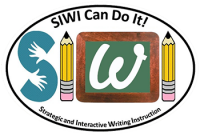Practices and Routines In SIWI Lessons That Develop Reading Proficiency For D/HH Learners
Tags: fingerspelling, interactive, rereading, word identificationThe average performance of Deaf and hard of hearing (D/hh) students on tests of reading comprehension is several grade equivalents below their high school hearing peers. This study explored how the reading-writing connection evident in instruction driven with a high fidelity to the principles of Strategic Interactive Writing Instruction (SIWI) addresses the literacy challenges of D/hh learners. The video footage of SIWI lessons in two grade three classrooms were examined using a comingling of inductive and interpretive analysis and utilizing Spradley’s nine semantic relationships to determine the instructional and learner practices and routines that supported development of word recognition skills. The following instructional and learner practices and routines were identified: engaging students in cognitively demanding discourse that featured extended discourse and persistence in questioning; a high volume of repeated and wide reading; high volume of writing; multiple representation of words with an emphasis on fingerspelling; and attending to language input.
Read in Full